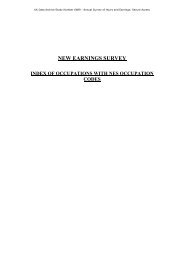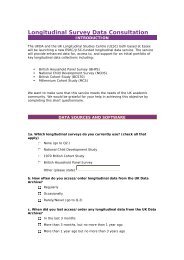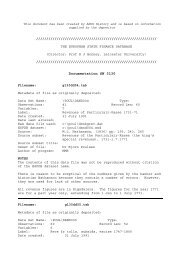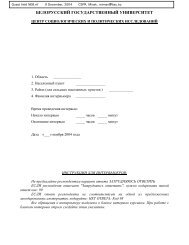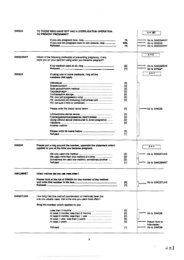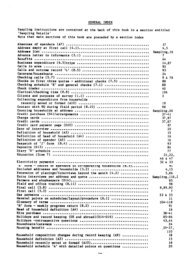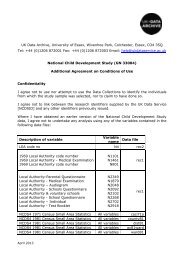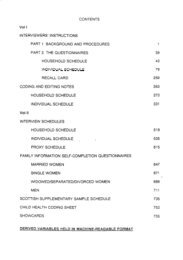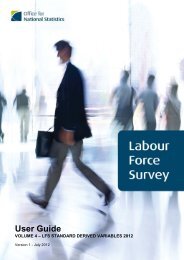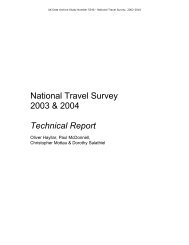ESDS Annual Report, 2008-2009
ESDS Annual Report, 2008-2009
ESDS Annual Report, 2008-2009
Create successful ePaper yourself
Turn your PDF publications into a flip-book with our unique Google optimized e-Paper software.
1,000,000<br />
900,000<br />
800,000<br />
700,000<br />
600,000<br />
500,000<br />
400,000<br />
300,000<br />
200,000<br />
100,000<br />
0<br />
Aug-07<br />
Sep-07<br />
Web site usage<br />
As the previous section on data access demonstrated, the<br />
internet is clearly the major tool for the delivery of <strong>ESDS</strong><br />
products and services. However, many web statistics<br />
can be misleading since uncorrected counts will give an<br />
artificially high figure due to the site being trawled by<br />
so-called web-crawlers as well as page calls to image<br />
files (pictures, logos and the like). Once these corrections<br />
have been implemented, the total number of page hits<br />
in the reporting year was 27 per cent up at 8,953,315,<br />
compared to a figure of 7,068,221 for the previous year.<br />
The pattern of hits over the last two years is shown in<br />
Figure 1 and perhaps the most noticeable features of this<br />
graph are the steady background increase and the peak<br />
figure in October, always the busiest time of the year but<br />
exceptionally high in <strong>2008</strong>.<br />
Usage by user type<br />
Oct-07<br />
Nov-07<br />
Breaking usage of the various services down by type<br />
or section of user, as shown in Table 8, illustrates<br />
that the principal user groups continue to be drawn<br />
from academic staff and students at institutions of<br />
higher education, ranging from 85 per cent (<strong>ESDS</strong><br />
Government) to 97 per cent (<strong>ESDS</strong> Qualidata).<br />
Public sector workers (central and local government,<br />
charitable organisations, non-governmental<br />
organisations (NGOs), etc.) tend to account for<br />
between 6 and 12 per cent of usage for most<br />
Figure 1 Web site use August 2007 to July <strong>2009</strong> (page hits)<br />
Dec-07<br />
Jan-08<br />
Feb-08<br />
Mar-08<br />
Apr-08<br />
May-08<br />
Jun-08<br />
Jul-08<br />
Aug-08<br />
Sep-08<br />
Oct-08<br />
Nov-08<br />
Dec-08<br />
Jan-09<br />
Feb-09<br />
Mar-09<br />
services. The exception to the general trend is with<br />
international macrodata, where licensing arrangements<br />
imposed by the data owners restrict use primarily<br />
to the academic sector. Here use is more heavily<br />
concentrated towards students, both under- and postgraduates,<br />
who jointly account for some 82 per cent<br />
of use, thus supporting the building of future research<br />
capacities.<br />
Usage by discipline<br />
Apr-09<br />
May-09<br />
Jun-09<br />
Jul-09<br />
Table 9 shows the relative proportions of active users<br />
in the most popular disciplinary areas for each of the<br />
specialist services. With some variations, the largest<br />
disciplinary users across all services are economics<br />
and sociology, with international macrodata being<br />
particularly heavily used by the former, and less so by<br />
the latter - whilst for qualitative data, the reverse is<br />
true. International macrodata, more so than others, are<br />
also widely used by the business/accounting/finance<br />
sector, which is not surprising given the nature of much<br />
of these data. What is perhaps most striking is the fact<br />
that all types of data have a broad and wide-ranging<br />
disciplinary appeal, suggesting that <strong>ESDS</strong> reaches much<br />
further than the core social sciences, including in its<br />
varied user community, health and medical researchers,<br />
humanities researchers as well as others.<br />
E C O N O M I C A N D S O C I A L DATA S E RV I C E A N N UA L R E P O RT AU G U S T 2 0 0 8 – J U LY 2 0 0 9 2 7




